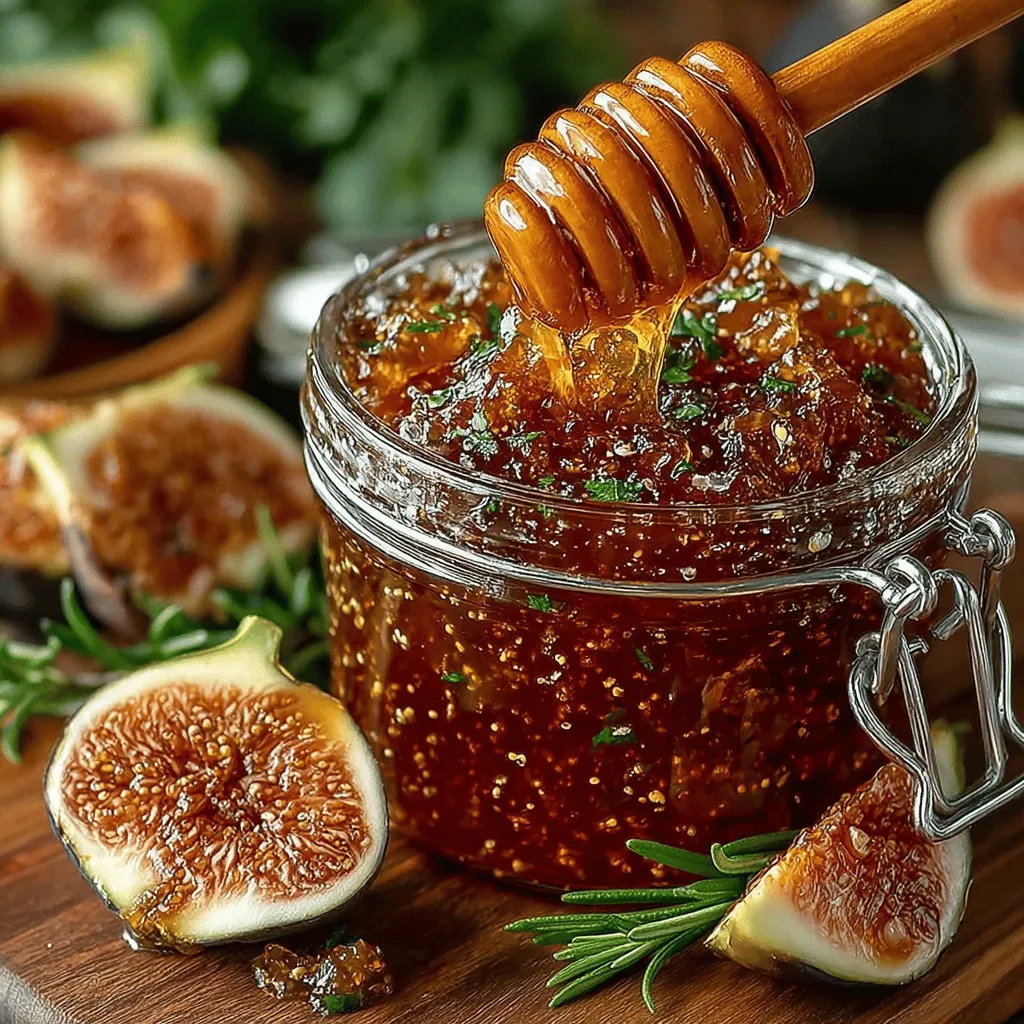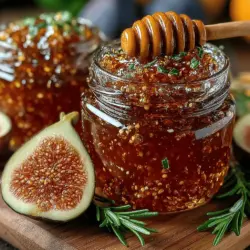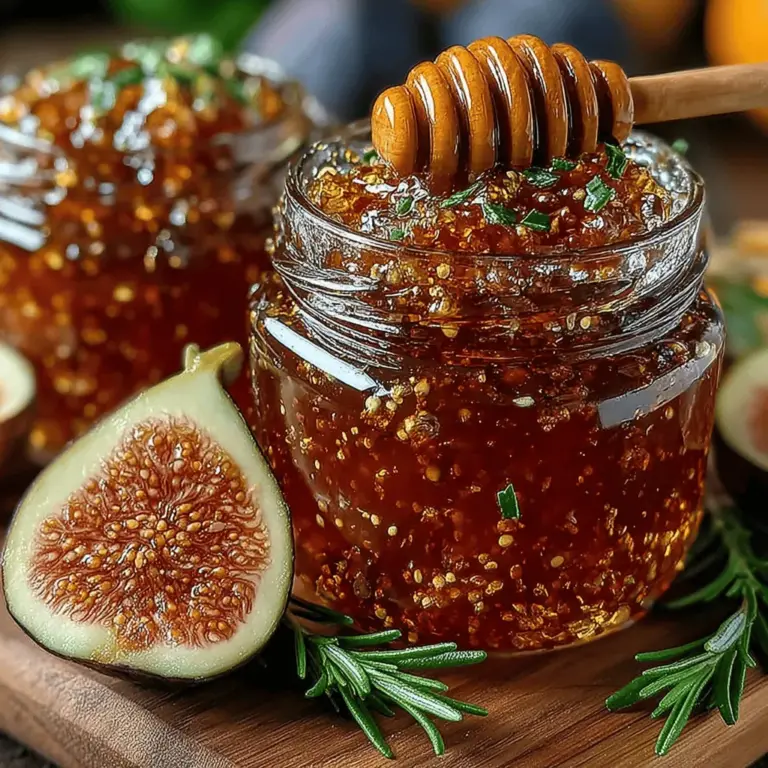Introduction
Fig jam is a culinary treasure that brings together the rich, luscious sweetness of fresh figs with a hint of savory complexity. This delightful preserve is not just a topping for your morning toast; it’s a versatile accompaniment that can enhance a variety of dishes. Whether slathered on a cheese platter, paired with meats, or used as a filling in pastries, fig jam offers a unique flavor profile that captivates the senses.
In recent years, the trend of homemade preserves has gained momentum, as more people seek to create artisanal products in their own kitchens. Making fig jam at home not only allows you to control the ingredients but also gives you the satisfaction of crafting something truly special. With fresh figs available during the late summer and early fall, there’s no better time to try your hand at this savory-sweet fig jam recipe.
Understanding Figs: Nature’s Sweet Delight
Figs have a rich history that dates back thousands of years, making them one of the oldest cultivated fruits in the world. They have been a staple in Mediterranean diets and hold significant cultural importance in various societies. Ancient Greeks and Romans valued figs not only for their delightful taste but also for their nutritional benefits. Today, figs are enjoyed globally, celebrated for their versatility in both sweet and savory dishes.
From a nutritional standpoint, figs are a powerhouse of health benefits. They are an excellent source of dietary fiber, which aids in digestion and promotes gut health. Figs are also rich in essential vitamins and minerals, including vitamin B6, potassium, magnesium, and calcium. These nutrients contribute to overall well-being, supporting heart health and bone strength. Additionally, figs are high in antioxidants, which help combat oxidative stress and inflammation in the body.
When it comes to selecting figs at the market, freshness is key. Look for figs that are plump, tender, and free from blemishes. The skin should be smooth and slightly shiny, indicating ripeness. Since figs do not ripen significantly after being picked, it’s best to choose those that are already at their peak. Remember that the season for fresh figs is relatively short, typically lasting from late summer to early fall, so seize the opportunity while they are available.
Ingredients Breakdown: Sweet Meets Savory
Creating a delightful fig jam requires a balance of flavors, and each ingredient plays a crucial role in crafting this savory-sweet masterpiece. Here’s a closer look at the key components of the recipe:
Fresh Figs: The Star of the Show
The main ingredient, fresh figs, provides the jam’s foundation with their natural sweetness and unique texture. When cooked down, figs transform into a luscious spread that captures their essence.
Granulated Sugar and Honey: Balancing Sweetness and Flavor
To enhance the sweetness of the figs, a combination of granulated sugar and honey is used. Sugar helps to preserve the jam, while honey adds a distinct depth of flavor, contributing to the complex taste profile. The balance between these sweeteners ensures that the fig jam is pleasantly sweet without being overly sugary.
Balsamic Vinegar: Adding Depth and Complexity
Balsamic vinegar brings an unexpected twist to the fig jam, introducing a tangy element that enhances the overall flavor. Its rich, complex notes complement the sweetness of the figs, resulting in a well-rounded preserve that can elevate both sweet and savory dishes.
Vanilla Extract and Lemon Juice: Enhancing Flavor Profiles
A splash of vanilla extract adds warmth and aromatic notes, enriching the jam’s flavor. Meanwhile, lemon juice introduces a bright acidity that balances the sweetness of the figs and sugar. This combination creates a harmonious blend that makes each bite of fig jam a delight.
Fresh Rosemary: Optional Herb for an Aromatic Twist
For those looking to add an herbal touch, fresh rosemary can be incorporated into the recipe. Its earthy notes elevate the jam, giving it a sophisticated twist that pairs beautifully with cheeses and meats.
Ground Black Pepper and Salt: Balancing Sweetness with Savory Notes
Finally, a pinch of ground black pepper and a small amount of salt work to balance the sweet and savory elements of the jam. These seasonings enhance the flavor without overpowering the natural sweetness of the figs, allowing the jam to shine.
Step-by-Step Guide to Making Fig Jam
Now that you understand the key ingredients and their roles in creating fig jam, it’s time to dive into the step-by-step process of making this delightful preserve. Follow these detailed instructions to ensure your fig jam turns out perfectly:
Step 1: Prepare the Figs
Begin by rinsing your fresh figs under cool water to remove any dirt or debris. Gently pat them dry with a clean towel. Once clean, remove the stems and cut the figs into quarters or smaller pieces, depending on your texture preference. If you prefer a smoother jam, you can chop them more finely.
Step 2: Combine Ingredients
In a large, heavy-bottomed pot, combine the prepared figs with granulated sugar, honey, balsamic vinegar, vanilla extract, and lemon juice. If you’re using fresh rosemary, add it to the pot at this stage. Stir the mixture gently to combine all the ingredients, ensuring the figs are evenly coated with the sugars and liquids.
Step 3: Cook the Mixture
Place the pot over medium heat and bring the mixture to a gentle simmer. As the figs heat up, they will begin to release their juices, creating a syrupy consistency. Stir occasionally to prevent the mixture from sticking to the bottom of the pot. Continue to cook for approximately 20-30 minutes, or until the figs have broken down and the jam has thickened to your desired consistency.
Step 4: Season the Jam
Once the fig jam has thickened, taste it and adjust the flavor as needed. You can add a pinch of salt and a dash of ground black pepper to enhance the savory notes. If you prefer a sweeter jam, feel free to add more sugar or honey to suit your taste.
Step 5: Jar the Jam
When the fig jam reaches your preferred consistency, remove it from heat. If you like a smoother texture, you can use an immersion blender to puree the jam to your liking. Once you’re satisfied with the texture, ladle the hot jam into sterilized jars, leaving about ¼ inch of headspace at the top. Make sure to wipe the rims of the jars with a clean cloth to remove any residue that could prevent a proper seal.
Step 6: Seal and Store
Seal the jars with lids and place them upside down for a few minutes to create a vacuum seal. Afterward, flip them back upright and allow the jars to cool completely at room temperature. Once cooled, store your fig jam in the refrigerator. It can be enjoyed immediately but is even better after resting for a day or two, allowing the flavors to meld.
With these steps, you’ll have a delightful batch of homemade fig jam that encapsulates the essence of fresh figs with a savory-sweet twist. In the next part, we will explore creative ways to use your fig jam, from pairing suggestions to recipe ideas that will elevate your culinary creations. Stay tuned for more delicious inspiration!

Preparing the Figs
The foundation of a great fig jam begins with proper preparation. Start by washing your fresh figs thoroughly under cool running water to remove any dirt or residues. This step is crucial for ensuring that your jam is clean and safe to eat. After washing, pat the figs dry with a clean towel. Next, chop the figs into small, uniform pieces—about a quarter to half an inch. This chopping not only helps with even cooking but also allows the figs to release their natural juices more efficiently when combined with other ingredients.
Combining Ingredients
To create a harmonious blend of flavors, it’s important to combine the ingredients effectively. In a large mixing bowl, combine the chopped figs with sugar, lemon juice, and any spices you choose to include, such as cinnamon or vanilla. Use a wooden spoon or spatula to gently fold the ingredients together. This technique ensures that the sugar is evenly distributed and that the figs are coated in the lemon juice, which enhances their flavor while aiding in the preservation process. Let the mixture sit for about 30 minutes. This resting period allows the figs to macerate, drawing out their juices and creating a syrupy base for your jam.
Cooking the Mixture
Once the ingredients are well combined, it’s time to cook the mixture. Transfer the fig mixture to a large, heavy-bottomed pot. Set the heat to medium-low, allowing the sugar to dissolve slowly. Stir frequently to prevent the mixture from sticking to the bottom of the pot. As the figs begin to heat up, they will release more juices, transforming the mixture into a thick, bubbling concoction. It’s essential to keep a close eye on the heat; too high can cause the jam to scorch, while too low may prolong cooking time unnecessarily.
Simmering the Jam
Simmering is a critical step in the jam-making process. After bringing the mixture to a gentle boil, reduce the heat to maintain a steady simmer. This is where the magic happens, as the mixture thickens and the flavors meld together beautifully. Simmer for about 30 to 45 minutes, stirring occasionally. You’ll know the jam is ready when it has reduced significantly and coats the back of a spoon. A good visual cue is when you drag your spoon across the bottom of the pot and the mixture holds its shape for a moment before flowing back together.
Checking Consistency
Testing the consistency of your jam is essential to ensure you achieve the desired thickness. There are a few methods to check this. The first is the plate test: Place a small plate in the freezer for a few minutes, then spoon a small amount of the jam onto the plate. Let it sit for a minute, then run your finger through the jam. If it holds its shape and wrinkles slightly, it’s ready to be jarred. Another method is to use a thermometer; fig jam is typically done when it reaches a temperature of around 220°F (104°C).
Jarring the Jam
Proper storage is vital for preserving the freshness of your fig jam. Before jarring, ensure that your jars are thoroughly sterilized to prevent any bacterial growth. You can do this by placing clean jars in a boiling water bath for 10 minutes or running them through a hot cycle in the dishwasher. Once sterilized, carefully ladle the hot jam into the prepared jars, leaving about a quarter-inch headspace at the top. Wipe the rims of the jars with a clean, damp cloth to remove any residue before sealing them with lids. Store the jars in a cool, dark place. If you plan to keep the jam for an extended period, consider processing the jars in a water bath canner for about 10 minutes to ensure a proper seal.
Optional Blending
Textural preferences can vary widely when it comes to jam. Some people love a chunky consistency, while others prefer a smoother product. If you fall into the latter category, you can use an immersion blender to purée the jam to your desired smoothness after cooking. Blend for just a few seconds to maintain some texture, or blend longer for a completely smooth consistency. Keep in mind that blending may alter the visual appeal of your jam, so choose based on your taste and presentation preferences.
The Versatility of Fig Jam: Pairing Suggestions
Fig jam is not just a delightful spread for your morning toast; its versatility allows it to shine in various culinary applications. Here are some pairing suggestions that will elevate your fig jam experience:
Pairing with Cheeses
One of the best ways to enjoy fig jam is paired with cheese. The sweetness of the jam beautifully complements a variety of cheeses. Soft cheeses like goat cheese or brie create a lovely contrast with the rich flavors of fig jam. Blue cheese, with its sharp and tangy profile, also pairs well, balancing the sweetness of the jam. For a more robust option, try it with aged cheddar or gouda. Serve your cheese board with fig jam for an elegant appetizer or snack.
Culinary Uses
Fig jam can elevate savory dishes as well. Incorporate it into roasted meats, such as pork or duck, for a flavorful glaze. Its sweetness balances the savory notes of the meat, creating a mouthwatering dish. You can also use fig jam in salad dressings; simply whisk it with olive oil, vinegar, and mustard for a unique vinaigrette. This jam can add complexity to savory tarts or flatbreads, making it a versatile ingredient in your kitchen.
Dessert Applications
The sweetness of fig jam makes it a fantastic addition to various desserts as well. Use it as a filling for pastries, such as danishes or turnovers. In cheesecakes, swirl fig jam into the batter before baking for a beautiful marbled effect. Drizzle it over vanilla ice cream or panna cotta for a simple yet sophisticated dessert. The possibilities are endless, allowing your creativity to shine.
Storage and Shelf Life of Fig Jam
Understanding how to store your fig jam properly is crucial for maintaining its freshness and flavor.
Refrigeration vs. Canning
If you plan to consume your jam within a few weeks, simply store it in the refrigerator after opening. This method retains the freshness of your jam but limits its shelf life. For long-term storage, canning is the preferred method. Properly canned fig jam can last up to a year when stored in a cool, dark place. Always check seals and ensure jars are intact before consuming.
How Long to Keep the Jam and Signs of Spoilage
Homemade fig jam is best enjoyed within a year. However, it can be safe to eat for longer if stored properly. Signs of spoilage include off-smells, discoloration, or mold growth. If you notice any of these signs, it’s best to discard the jam. Always practice safe canning techniques to minimize the risk of foodborne illnesses.
Conclusion
Creating homemade fig jam is a rewarding experience that allows you to savor the delights of this unique fruit year-round. From the initial preparation to the final jarring, the process offers a sense of accomplishment and joy. The versatility of fig jam enables it to elevate both sweet and savory dishes, making it an essential ingredient in any kitchen. Embrace the art of making preserves and enjoy the delightful flavors of fig jam, knowing that with each batch, you’re crafting a delicious addition to your culinary repertoire. So gather your figs, follow the steps, and indulge in the sweet satisfaction of your homemade creation.

